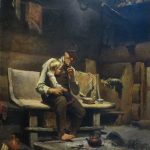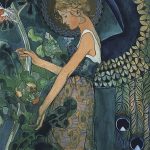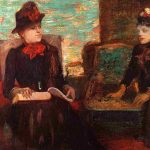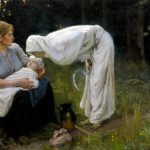Josef Loukota, a name less familiar to the broader audience yet significant within the context of Czech and Central European art, was born on December 15, 1861, in Chrudim, Austria-Hungary (now Czech Republic). His artistic journey is a reflection of the cultural and political ferment of his times, spanning the turn of the 20th century, a period marked by rapid modernization, national awakening, and the quest for a distinct cultural identity among the Slavic peoples of the Austro-Hungarian Empire.
Loukota’s early life and education were steeped in the rich traditions of his homeland, which would later influence his artistic creations. He pursued his art education at the Academy of Fine Arts in Prague, an institution that played a crucial role in shaping the artistic talents of the region. His studies there equipped him with the technical skills and aesthetic sensibilities that would underpin his later work. Furthering his education, Loukota traveled to Munich, a city that was a hub for artistic innovation and experimentation at the turn of the century. Munich provided him with exposure to new ideas and artistic movements, enriching his understanding and appreciation of art’s possibilities.
Returning to the Czech lands, Loukota found himself in a society brimming with nationalistic fervor and a renaissance of Slavic culture and heritage. He became an active participant in the burgeoning cultural scene, contributing to the development of a distinct Czech art that sought to express the nation’s identity and aspirations. His work during this period reflects a deep engagement with Czech folklore, history, and the natural beauty of his homeland, themes that resonated with the nationalist sentiments of his compatriots.
Loukota’s artistic style was characterized by a blend of realism and symbolism, with a penchant for capturing the ethereal beauty of landscapes and the nuanced expressions of human figures. He was adept at various mediums, including painting, illustration, and graphic art, demonstrating versatility and a keen eye for detail. His landscapes, often depicting the rolling hills, ancient forests, and picturesque villages of Bohemia and Moravia, are imbued with a sense of tranquility and timeless beauty. These works not only celebrate the natural splendor of the Czech lands but also evoke the deep historical and spiritual connections that the people shared with their environment.
Aside from his landscapes, Loukota is noted for his contributions to illustration and graphic arts, particularly his work on books and periodicals. In these endeavors, he employed his skills to bring literary works to life, illustrating the tales and legends of Czech folklore with imagination and sensitivity. His illustrations helped to popularize these stories, fostering a sense of pride and belonging among the Czech people.
Throughout his career, Josef Loukota remained committed to the idea that art should serve as a vehicle for expressing and shaping national identity. His works are a testament to the power of art to encapsulate the spirit of a time and place, embodying the hopes, dreams, and aspirations of a nation on the cusp of significant change.
Despite the challenges of working in an era of political upheaval and social change, Loukota’s contributions to Czech art were recognized and appreciated by his contemporaries. Today, while he may not be as widely known as some of his peers, his legacy endures in the Czech Republic and among connoisseurs of Central European art. His paintings and illustrations continue to be cherished for their beauty, craftsmanship, and deep cultural resonance, offering a window into the soul of the Czech nation during a pivotal period in its history.
Josef Loukota passed away on February 14, 1942, leaving behind a body of work that continues to inspire and captivate. In a broader sense, his art serves as a reminder of the enduring power of cultural expression to define, unite, and elevate a people, making his contribution to Czech art an integral part of the nation’s cultural heritage.





